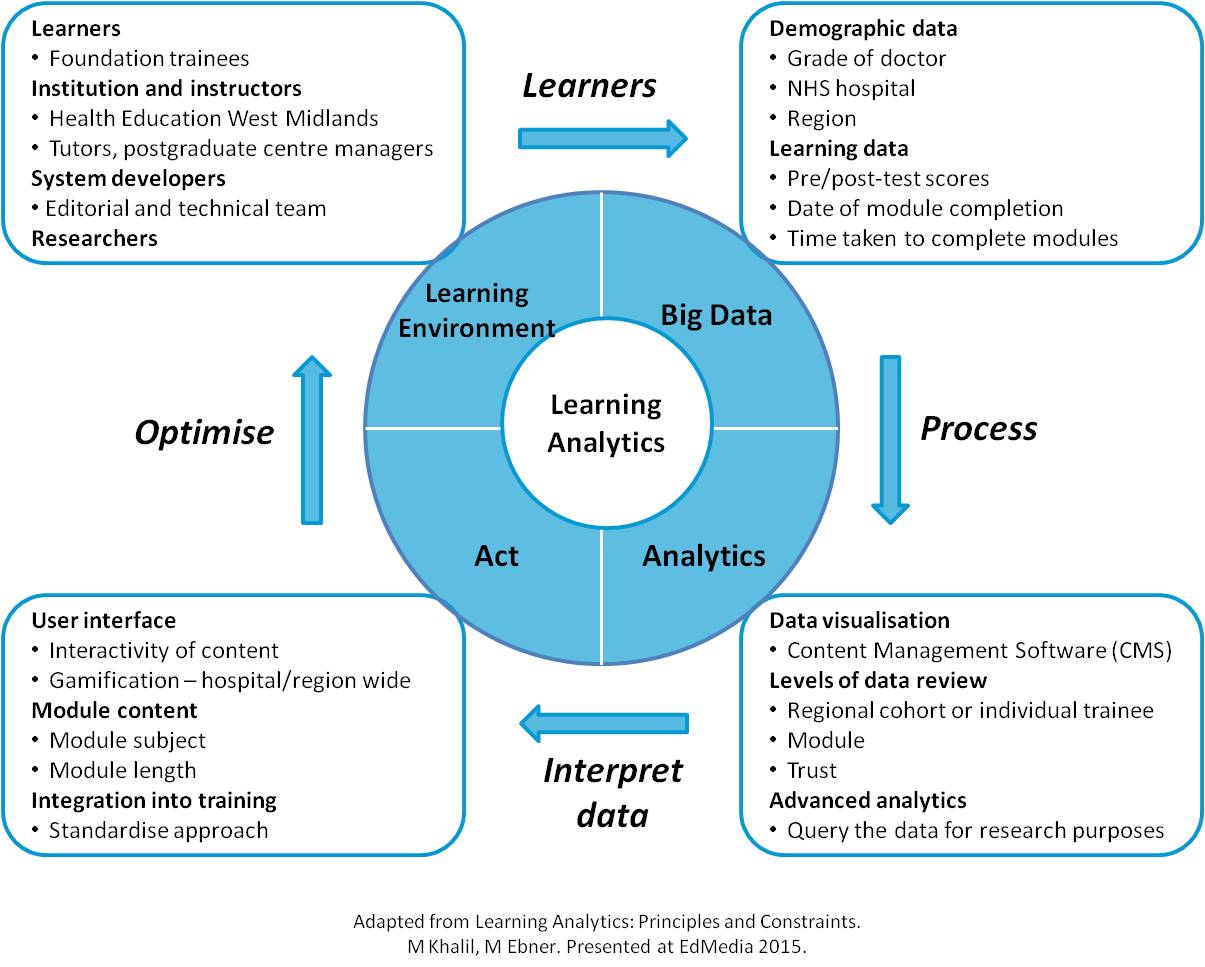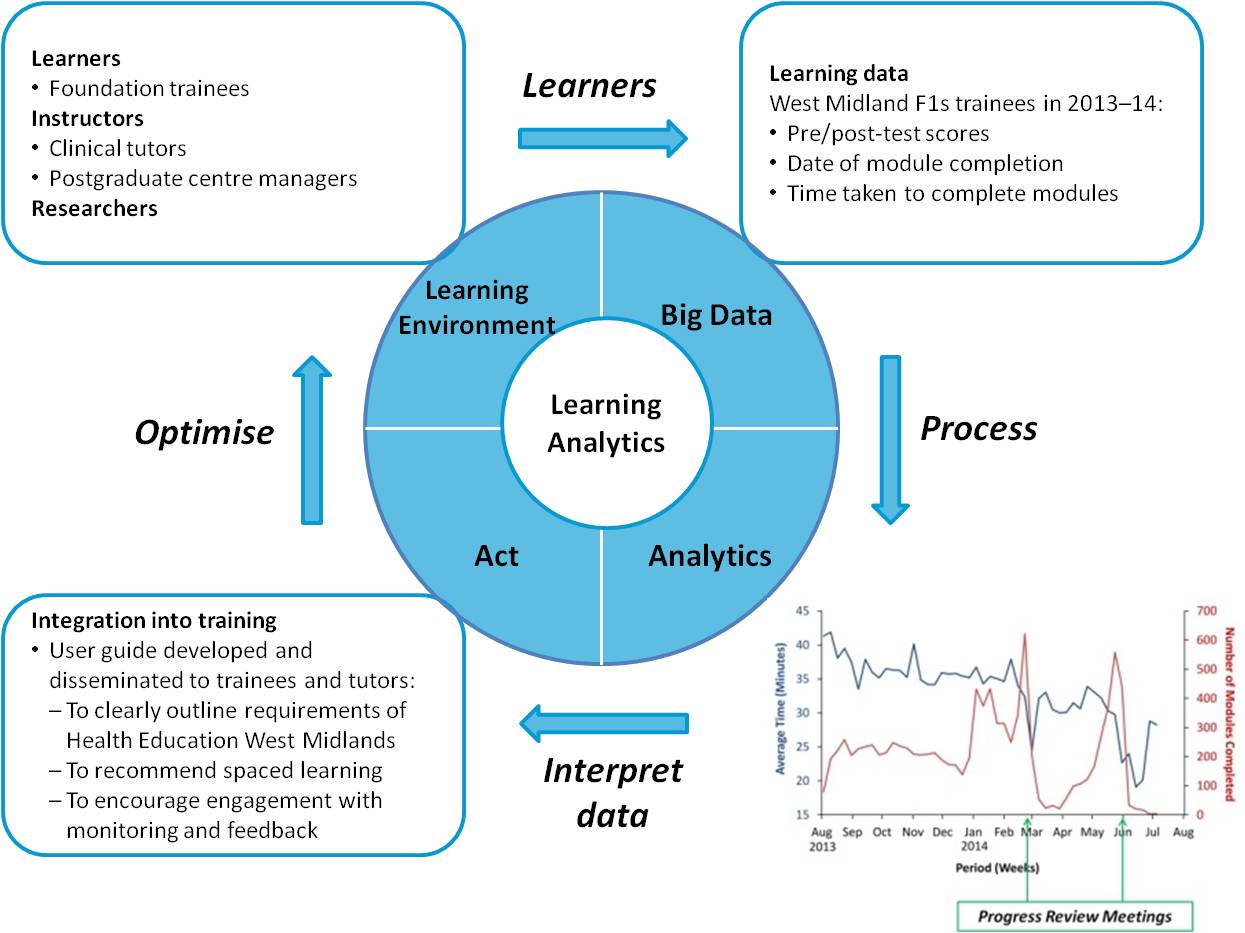ePOSTER


Abstract Title
Learning analytics of an online eLearning programme: A descriptive account


Theme
4AA eLearning courses
INSTITUTION
University of Birmingham - College of Medical and Dental Sciences - United Kingdom
OCB Media Ltd - United Kingdom
Health Education West Midlands

Background
- SCRIPT eLearning was commissioned by Health Education West Midlands to improve the prescribing competency of its Foundation trainees in response to concerns about the rate of prescribing errors [1]. The web-based programme (www.safeprescriber.org) comprises 44 modules relating to prescribing and therapeutics. Each module takes approximately 30-40 minutes to complete. A pre/post-test enables trainees to assess their baseline knowledge and learning.
- A web-based management programme enables tutors and postgraduate centre managers to monitor the progress of their trainees, with access to: date and time of module completion; test scores; and time spent on modules. System developers are also able to run specific learning analytic queries within the Content Management System (CMS).We have developed a number of learning analytic approaches to assist in the evaluation of user interactions to inform both system enhancements and educational development of trainees. Here we present a model based on a Plan-Do-Study-Act cycle (Figure 1) that informs our analytic approach.
Summary of Work
Our web-based learning analytics facilitates:
- Trainee feedback: timely feedback is provided to trainees to identify and raise issues relating to their learning or performance.
- Monitoring of mandated learning: in the West Midlands, trainees are required to complete 16 modules in F1, and a further 15 in F2. The technology is used to track their progress against these educational goals.
- Monitoring of user behaviour: behaviours can be identified that may indicate suboptimal learning. For example, trainees who complete a module in less than 10 minutes are highlighted within the management site so that the tutor can initiate one-to-one engagement with the trainee. This may include a discussion about protected study time or difficulty with specific subjects.
- Interface design and content development: the average time taken to complete a module can be monitored and the content modified accordingly. For example, modules taking in excess of 45 minutes have been divided into two separate learning events.
Take-home Messages
The availability of data from our eLearning platform can:
- Assist educators with the integration of eLearning into formal Foundation training.
- Assist clinical and educational supervisors with the monitoring of trainees and the provision of valuable feedback and support.
- Inform system developers to optimise user engagement and motivation to participate in the learning.
Conclusion
The use of learning analytics has enabled the modifications to the SCRIPT eLearning programme and its integration into training for Foundation trainees.
TRAINING
- Integration into training: we have clearly outlined the institutional requirements for the trainee.
- Engagement: we have recommended trainees space their learning, completing 2–3 modules per month. We have requested increased engagement from tutors and postgraduate centre managers to encourage this approach on a local level.
- Motivation: we have developed a learning performance dashboard, providing users with visual feedback in the form of charts and graphs detailing their personal learning progress, as well as comparing performance against their peers.
INTERFACE AND CONTENT
- Interface: we have redesigned the user interface to provide an updated aesthetic and improved user experience.
- Management site: we have further developed the management site to allow for more detailed analytics and usage statistics at user, National Health Service (NHS) Trust and regional levels. This been developed to provide an unprecedented level of user monitoring, to the extent that individual SCORM interactions are recorded and reported for audit and review purposes.
- Module content: modules have been shortened where the average length of time to complete is more than 45 minutes.
Acknowledgement
We would like to thank:
- Health Education West Midlands.
- OCB Media Ltd.
- Our dedicated SCRIPT authors and peer reviewers.
Summary of Results
Figure 1: Plan-Do-Study-Act Cycle for Learning Analytics

Figure 2: The SCRIPT Plan-Do-Study-Act Cycle in practice

References
- Dornan, T., Ashcroft, D., Heathfield, H., et al. (2009) An in depth investigation into causes of prescribing errors by foundation trainees in relation to their medical education. EQUIP study. [online]. http://www.gmc-uk.org/about/research/research_commissioned_4.asp
- Thomas SK, Blackwell B, Cox A Robin Ferner1, Hirsch C, Hughes E, Marriott J, Coleman JJ. SCRIPT eLearning for Prescribing and Therapeutics: impact on knowledge, skills and patient safety. Proceedings of the British Pharmacological Society Winter Conference, Pharmacology 2013 [Dec 2013, London]. Available online at http://www.pa2online.org/abstract/abstract.jsp?abid=31354&kw=script&author=thomas&cat=-1&period=-1
 Send Email
Send Email